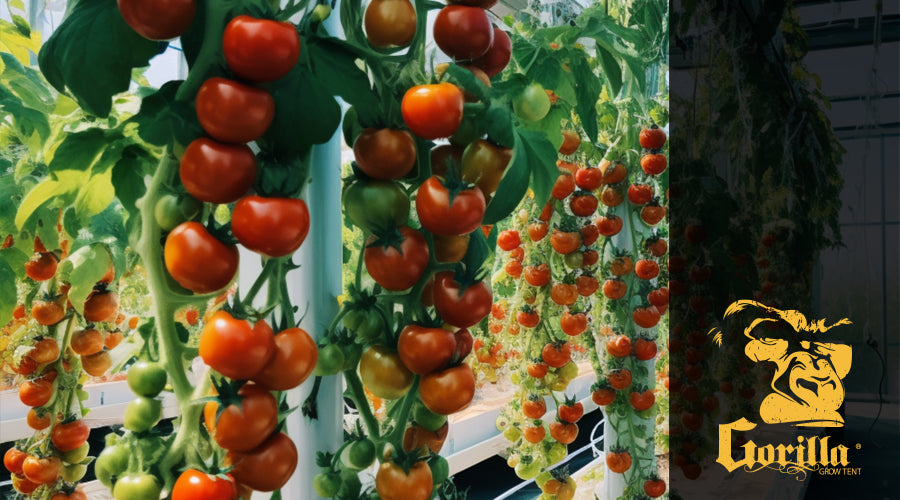
Hydroponic Tomatoes: A Comprehensive Guide
In the realm of agriculture, hydroponics has emerged as a transformative technique, revolutionizing the way we grow crops. Unlike traditional soil-based cultivation, hydroponics involves immersing plant roots in nutrient-rich water solutions, eliminating the need for soil. This innovative approach has garnered significant attention, particularly in the cultivation of tomatoes, a versatile and widely consumed fruit.
Embark on a journey to explore the world of hydroponic tomatoes, delving into their benefits, techniques, and future prospects.

Benefits of Hydroponic Tomatoes
The cultivation of hydroponic tomatoes offers a plethora of advantages compared to conventional soil-based methods. These benefits encompass:
Enhanced Yields: Hydroponic systems provide precise control over nutrient uptake and water distribution, resulting in increased yields and larger, healthier tomatoes.
Reduced Water Consumption: Hydroponic systems conserve water by utilizing a closed-loop system, minimizing evaporation and nutrient runoff. This water-efficient approach is particularly beneficial in areas with limited water resources.
Disease and Pest Resistance: The absence of soil in hydroponic systems reduces the risk of soilborne diseases and pests, leading to healthier plants with minimal reliance on pesticides or herbicides. This translates to a cleaner and safer crop production process.
Year-round Production: Hydroponic systems can be controlled to maintain optimal growing conditions, enabling year-round production of tomatoes, regardless of external weather patterns. This adaptability allows for a consistent supply of fresh tomatoes throughout the year.
Improved Flavor: Hydroponic tomatoes often exhibit a sweeter and more intense flavor profile compared to their soil-grown counterparts. This enhanced taste is attributed to the precise nutrient delivery, which contributes to a balanced flavor profile.
Compact Growing Space: Hydroponic systems can be vertically stacked, maximizing vertical space and allowing for cultivation in limited areas, such as balconies or garages.
Hydroponic Tomato Techniques
Numerous hydroponic techniques have been developed for cultivating tomatoes, each with its unique advantages and considerations. The choice of technique depends on factors such as the desired scale of production, available space, and personal preferences. Here's an overview of some common hydroponic tomato methods:
Deep Water Culture (DWC): Plants are suspended in net pots with roots submerged in a constantly aerated nutrient solution. This method is relatively simple to set up and maintain, making it suitable for beginners.
Nutrient Film Technique (NFT): A thin film of nutrient solution flows over the roots of plants suspended in a channel. This method is highly efficient in water usage and requires minimal maintenance.
Drip Systems: The nutrient solution is dripped directly onto the roots of plants at regular intervals. This technique is versatile and can be adapted to different growing spaces.
Aeroponics: Plants are suspended in a chamber, and their roots are misted with nutrient solutions at regular intervals. This method allows for maximum root exposure to oxygen, promoting rapid growth and nutrient uptake.
Choosing the Right Hydroponic Technique
The selection of the most suitable hydroponic technique depends on several factors:
Growing Scale: For small-scale production, DWC or drip systems are often preferred due to their ease of setup and maintenance. For larger-scale production, NFT or aeroponics may be more efficient.
Available Space: If space is limited, vertical hydroponic systems, such as Dutch buckets or vertical towers, can be employed to maximize space utilization.
Personal Preferences: Some growers may prefer the simplicity of DWC or drip systems, while others may be drawn to the unique flavor and growth characteristics of aeroponics.
Establishing a Hydroponic Tomato Garden
Establishing a hydroponic tomato garden is an exciting endeavor that allows you to enjoy fresh, homegrown tomatoes all year round. While it may seem daunting at first, the process can be simplified by following a step-by-step guide.
Gather Essential Supplies:
Before embarking on your hydroponic journey, gather the necessary supplies, including:
A hydroponic system: Choose a system that suits your space, skill level, and desired production scale. Popular options include Deep Water Culture (DWC), Nutrient Film Technique (NFT), and Drip Systems.
Nutrient solution: Select a hydroponic tomato nutrient solution tailored to the specific growth stages of your plants.
Tomato seeds: Choose tomato varieties that are well-adapted to hydroponic cultivation and your climate.
Growing media: Options include rockwool cubes, perlite, or coco coir, depending on the hydroponic system.
Grow lights (if natural sunlight is limited): Ensure the lights provide adequate intensity and spectral range for tomato growth.
pH and EC meters: Monitor and adjust the nutrient solution's pH and nutrient concentration.
Set Up Your Hydroponic System:
Assembly instructions will vary depending on the chosen system. Generally, the process involves:
Installing the hydroponic structure, such as a reservoir, net pots, and channels.
Connecting the water pump and tubing to circulate the nutrient solution.
Add the growing media to the net pots and place them in the designated spots.
Prepare the Nutrient Solution:
Follow the instructions on the hydroponic tomato nutrient solution package. Mix the recommended amount of nutrients with water, ensuring the pH is within the optimal range of 5.5-6.5.
Germinate Tomato Seeds:
Start your tomato journey by germinating the seeds. Place them in a moist growing medium, such as rockwool cubes, and maintain a warm, humid environment. Once seedlings emerge, transfer them to the hydroponic system.
Nurturing Your Hydroponic Tomatoes
Nurturing your hydroponic tomatoes requires careful attention to their needs, ensuring they receive the optimal conditions for thriving.
Provide Adequate Lighting:
Tomatoes are sun-loving plants, requiring at least 6-8 hours of direct sunlight daily for optimal growth and fruit production. If natural sunlight is limited, consider supplementing with grow lights to maintain the required light duration and intensity.
Maintain Optimal Temperature and Humidity:
Tomatoes prefer warm temperatures, ideally between 65-75°F (18-24°C) during the day and slightly cooler at night. Maintain a humidity level of around 50-60% to prevent moisture stress and promote healthy leaf growth.
Balanced Nutrient Solution:
Hydroponic tomatoes rely on a nutrient solution to provide essential nutrients for growth and fruit development. Use a commercially available hydroponic tomato nutrient solution or prepare your own, following a balanced formula that includes macronutrients, micronutrients, and chelated elements.
Regular Nutrient Monitoring and Adjustments:
Monitor the pH and nutrient concentration of the nutrient solution regularly, using a pH meter and an electrical conductivity (EC) meter. Adjust the nutrient solution as needed to maintain optimal levels for the specific growth stage of your tomato plants.
Proper Watering and Root Care:
The frequency of watering depends on the type of hydroponic system and the growth stage of the plants. Generally, water the plants when the roots appear dry or slightly dehydrated. Avoid overwatering, as this can lead to root rot.
Pruning and Support:
Prune tomato plants regularly to remove suckers, excess foliage, and diseased or damaged leaves. This allows for better air circulation, reduces the risk of diseases, and directs energy towards fruit production. Provide support for the plants as they grow taller, using stakes, trellises, or cages.
Pest and Disease Prevention:
Inspect your tomato plants regularly for signs of pests or diseases. Common pests include aphids, whiteflies, and spider mites. Common diseases include early and late blight, Septoria leaf spot, and tomato mosaic virus. Use organic pest control methods whenever possible, such as insecticidal soap or Neem oil. For diseases, practice good sanitation, avoid overhead watering, and consider using fungicides if necessary.
Pollination and Fruit Development:
Tomatoes are self-pollinating plants, but gentle shaking or using a vibrating pollinator can help ensure adequate pollination and fruit set. As fruits develop, monitor their color and texture. Tomatoes are ripe when they turn from green to their mature color, typically red, yellow, or orange, and feel slightly soft when gently squeezed.
Harvest tomatoes when they are fully ripe and enjoy them fresh in salads, sauces, or preserves. Proper harvesting techniques include using sharp scissors or garden shears to cut the stems above the calyx.


